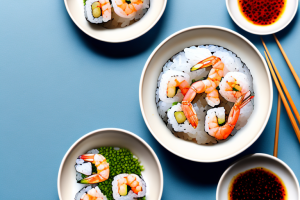How to stir-fry sushi rice with kimchi
9 min read
A pan with stir-fried sushi rice and kimchi
If you love sushi and kimchi, then you’re in for a treat with this recipe for stir-fried sushi rice with kimchi! In this article, we’re going to provide you with a step-by-step guide on how to prepare this delicious dish in the comfort of your own home. Let’s get started!
Ingredients needed for the recipe
Before we start the cooking process, let’s gather all the ingredients we need for the recipe. For this dish, you will need:
- 2 cups of sushi rice
- 3 cups of water
- ¼ cup of rice vinegar
- 2 tablespoons of sugar
- 1 teaspoon of salt
- 2 tablespoons of vegetable oil
- ½ cup of chopped kimchi
- 2 cloves of garlic, chopped
- 1 tablespoon of soy sauce
- 1 tablespoon of sesame oil
- 2 green onions, chopped
It’s important to note that the quality of the ingredients can greatly affect the taste of the dish. When selecting your sushi rice, look for a high-quality brand that is specifically labeled as sushi rice. For the kimchi, try to find a brand that is made with fresh ingredients and has a good balance of spice and sourness. Additionally, using fresh garlic and green onions will enhance the overall flavor of the dish.
Step-by-step guide on how to prepare sushi rice
Now that we have all the ingredients ready, let’s start by preparing the sushi rice:
- Rinse the sushi rice with cold water until the water runs clear. This will remove any excess starch from the rice.
- In a medium-sized pot, combine the rinsed rice with 3 cups of water and bring it to a boil.
- Once the water is boiling, reduce the heat to low and let the rice simmer for about 18 minutes or until all the water has been absorbed.
- Remove the pot from the heat and let it sit covered for 10 minutes to allow the rice to absorb the remaining moisture.
- In a small bowl, mix together the rice vinegar, sugar, and salt until the sugar and salt have dissolved.
- Add the mixture to the cooked rice and gently stir it in. Be careful not to crush the rice while mixing.
Now that you have prepared the sushi rice, it’s important to know how to store it properly. Sushi rice should be stored at room temperature and covered with a damp cloth to prevent it from drying out. It’s best to use the rice within a few hours of preparing it, but if you need to store it for longer, you can keep it in the refrigerator for up to two days.
Another important tip to keep in mind is that the quality of the rice you use can greatly affect the taste and texture of your sushi. Look for short-grain Japanese rice, which is specifically grown for making sushi. Avoid using long-grain rice or other types of rice, as they won’t have the same sticky texture that’s needed for sushi.
How to make homemade kimchi
If you’re feeling adventurous and want to make your own kimchi for this recipe, here’s a quick guide on how to make it:
- Chop one head of Napa cabbage into bite-sized pieces and sprinkle with 2 tablespoons of salt. Let it sit for about 1 hour.
- Rinse the salt off the cabbage and squeeze out the excess water.
- In a food processor, pulse together 1 tablespoon of ginger, 3 cloves of garlic, 2 tablespoons of fish sauce, and 1 tablespoon of red pepper flakes until a paste forms.
- In a large mixing bowl, combine the cabbage with the paste and mix well.
- Transfer the mixture to a glass jar and let it ferment at room temperature for about 2-3 days before transferring it to the fridge.
Kimchi is a traditional Korean dish that has been enjoyed for centuries. It is a fermented vegetable dish that is packed with flavor and nutrition. In addition to cabbage, you can also make kimchi with other vegetables such as radishes, cucumbers, and carrots.
There are many health benefits associated with eating kimchi. It is rich in vitamins and minerals, and the fermentation process creates probiotics that are beneficial for gut health. Kimchi is also low in calories and high in fiber, making it a great addition to any healthy diet.
Different types of kimchi that can be used for the recipe
While we recommend making your own kimchi for this recipe, you can also use store-bought kimchi. There are many types of kimchi available, such as:
- Baechu kimchi – made with Napa cabbage
- Kkakdugi – made with diced radishes
- Mulgogi – made with watermelon radish
- Oisobagi – made with cucumber
- Gat kimchi – made with mustard greens
Each type of kimchi has a unique flavor profile and texture, which can add a different dimension to your dish. For example, Baechu kimchi has a mild and slightly sweet taste, while Kkakdugi has a crunchy texture and a spicy kick. Mulgogi kimchi has a refreshing taste and is perfect for hot summer days, while Oisobagi kimchi has a refreshing and tangy taste that pairs well with grilled meats.
When choosing a type of kimchi for your recipe, consider the other ingredients and flavors in the dish. For example, if you are making a spicy stir-fry, you may want to use a milder kimchi to balance out the heat. Alternatively, if you are making a cold noodle salad, you may want to use a kimchi with a refreshing taste to complement the dish.
Tips on selecting the best quality sushi rice and kimchi
When it comes to selecting the best quality ingredients for this recipe, here are a few tips to keep in mind:
- For the sushi rice, look for rice that is labeled as “short-grain” or “sushi rice”.
- When shopping for kimchi, look for brands that use natural ingredients and avoid those with added preservatives or artificial flavors.
- Check the expiration date on the kimchi before purchasing it to ensure it’s fresh.
Another important factor to consider when selecting sushi rice is the texture. Look for rice that is sticky and holds together well when rolled into sushi. This will ensure that your sushi rolls stay intact and don’t fall apart. Additionally, when selecting kimchi, consider the level of spiciness. Some brands offer mild or medium spiciness levels, while others are very spicy. Choose a level that suits your taste preferences.
Health benefits of eating sushi rice and kimchi
Aside from being delicious, both sushi rice and kimchi offer numerous health benefits:
- Sushi rice is a good source of carbohydrates and contains vitamins and minerals like thiamine, niacin, and magnesium.
- Kimchi is packed with vitamins, minerals, and antioxidants, and it’s also a good source of probiotics that can improve gut health.
In addition to the benefits mentioned above, sushi rice is also low in fat and cholesterol, making it a great option for those looking to maintain a healthy weight and reduce their risk of heart disease.
Similarly, kimchi has been shown to have anti-inflammatory properties, which can help reduce the risk of chronic diseases such as arthritis and certain types of cancer.
Best cooking utensils to use for stir-frying sushi rice with kimchi
When it comes to stir-frying, you want to use a wok or a large, deep frying pan. A wooden spatula or a pair of tongs will also come in handy for stirring and flipping the ingredients.
Another important utensil to have when stir-frying sushi rice with kimchi is a rice paddle. This will help you to gently stir and separate the grains of rice without breaking them. It’s also important to have a lid for your wok or frying pan, as this will help to trap steam and cook the rice evenly.
Additionally, if you’re using a gas stove, it’s a good idea to have a wok ring to stabilize your wok and prevent it from tipping over. This will also help to distribute heat evenly across the bottom of the wok, ensuring that your ingredients cook evenly.
How to achieve the perfect texture and flavor for your dish
To achieve the perfect texture and flavor for your stir-fried sushi rice with kimchi, here are a few tips to keep in mind:
- Ensure that the cooked sushi rice has cooled down before stir-frying it with the kimchi to prevent it from becoming mushy.
- Stir-fry the ingredients over high heat for a crispier texture.
- Adjust the seasoning to your liking by adding more soy sauce or sugar if needed.
Another important factor to consider when making stir-fried sushi rice with kimchi is the type of kimchi you use. Different types of kimchi have varying levels of spiciness and sourness, which can affect the overall flavor of the dish. Experiment with different types of kimchi to find the one that best complements the sushi rice.
Additionally, you can add other ingredients to the stir-fry to enhance the flavor and texture of the dish. Some popular additions include sliced mushrooms, diced carrots, and chopped scallions. These ingredients not only add flavor and texture but also provide additional nutrients to the dish.
Variations of the recipe that you can try out
If you’re feeling creative, here are some variations of the recipe that you can try:
- Add sliced beef or chicken to the dish for an extra protein boost.
- Replace the kimchi with other vegetables like bell peppers, carrots, or broccoli for a different flavor profile.
- Garnish the dish with sesame seeds, sliced green onions, or chopped cilantro for added flavor and texture.
Another variation you can try is to add a fried egg on top of the dish for a delicious breakfast or brunch option. You can also experiment with different types of noodles, such as udon or soba, to change up the texture of the dish. For a vegetarian option, you can substitute the meat with tofu or tempeh. Don’t be afraid to get creative and make the recipe your own!
Ways to serve stir-fried sushi rice with kimchi
This dish can be served as a main course or as a side dish. Here are some serving suggestions:
- Top it with a fried egg for a hearty breakfast meal.
- Pair it with grilled meats or seafood for a complete meal.
- Serve it as a side dish alongside other Korean dishes like bulgogi or japchae.
Another way to serve stir-fried sushi rice with kimchi is to add some vegetables like carrots, bell peppers, and onions to the stir-fry. This will not only add more flavor and texture to the dish but also make it more nutritious. You can also sprinkle some sesame seeds or chopped green onions on top for added crunch and freshness.
Frequently asked questions about preparing this dish
Here are some frequently asked questions about preparing stir-fried sushi rice with kimchi:
- Can I use brown rice instead of sushi rice? While brown rice can be used, it may affect the texture and flavor of the dish.
- Can I use other types of vinegar for the sushi rice? Yes, you can use other types of vinegar like apple cider vinegar or white wine vinegar if you prefer.
- Can I use other types of oil for stir-frying? Yes, other types of oil like canola oil or peanut oil can be used instead of vegetable oil.
How to store leftover stir-fried sushi rice with kimchi
If you have any leftovers, store them in an airtight container in the fridge for up to 3-4 days. To reheat, place the rice in a microwave-safe dish and heat it up in the microwave until it’s heated through.
How to reheat stir-fried sushi rice with kimchi without compromising its texture and taste
To ensure that the rice and kimchi maintain their texture and flavor, it’s best to reheat the dish in a pan or wok over medium-high heat. Add a little bit of oil to the pan and stir-fry the rice and kimchi until everything is heated through. Avoid reheating in the microwave as it can make the rice become mushy and the kimchi lose its crunch.
And there you have it, a comprehensive guide on how to stir-fry sushi rice with kimchi! With this recipe, you’re sure to impress your friends and family with your culinary skills.


